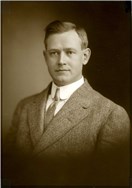 Oscar Hedstrom was co-founder of the Indian Motocycle Company. Hedstrom hand built the first Indian prototype in 1901. His engineering skills were responsible for giving the early Indians a reputation for solid construction and excellent reliability and helped catapult the company to the world's largest manufacturer of motorcycles.
Oscar Hedstrom was co-founder of the Indian Motocycle Company. Hedstrom hand built the first Indian prototype in 1901. His engineering skills were responsible for giving the early Indians a reputation for solid construction and excellent reliability and helped catapult the company to the world's largest manufacturer of motorcycles.
Carl Oscar Hedstrom was born in the little parish of Lönneberga in the province of Småland, Sweden, on March 12, 1871. His family emigrated to the United States and settled in New York City when Oscar was 9 years old. While a schoolboy, Oscar was given bicycle by his father. Hedstrom loved to ride the bicycle around the city and was intrigued by its mechanical workings.
At 16, Hedstrom took a job at a watchmaker's shop where he learned the use of machine tools, pattern making, forging and metallurgy. He worked as an apprentice for several small shops and earned journeyman status when he was 21.
In his spare time, Hedstrom applied his growing skills to his passion for bicycling. Working out of his home shop, he produced high-quality bicycles that were lighter and more durable than production models. As his reputation as a builder grew, he began making gasoline engines to power tandem bicycles used to pace races. The pacers were designed to split the wind for the bicyclists who rode in their draft while attempting speed records. The pacers of the time were mostly crude and unreliable machines, and Hedstrom earned a reputation for building reliable pacers.
While Hedstrom was building his pacers, former bicycle racing champion George Hendee, of Springfield, Massachusetts, was manufacturing bicycles and sponsoring races. He was dissatisfied with the crude pacers available, and asked Hedstrom to bring one his machines to Springfield. Hendee was impressed and asked Hedstrom to build a prototype of a mass-production motorized bicycle.
The partnership between the two men would eventually become the Indian Motocycle Company. Hedstrom's design was so innovative, it made the company an instant success. Hedstrom enjoyed supervising the rapidly expanding manufacturing operation, but he did not spend all his time in the shop. In 1903, he rode an Indian to a record 56 miles per hour on Ormond Beach in Florida. He continued attempting and coordinating record top-speed runs through the end of the decade.
In 1910, Hedstrom drew up plans for a new, five-story addition to the factory. The new factory, called the Wigwam, was completed in 1912, and Indian reached its high-water mark in 1913, when it produced 32,000 motorcycles, more than any other manufacturer in the world.
Hedstrom-designed engines powered all Indians produced until 1916. His designs were also used under license by other early American manufacturers. All told, more than 135,000 Hedstrom engines were produced.
Hedstrom died at home at age 89 in 1960. He was a major figure in the creation of motorcycling as we know it today.